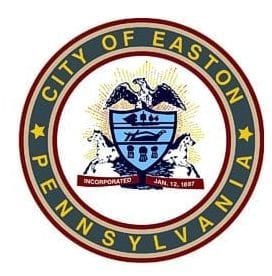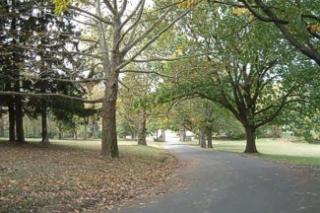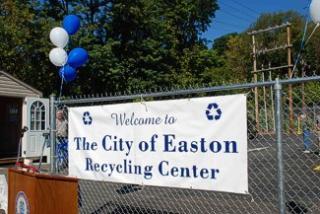 When people think of environmental health and sustainability in communities, some things come easily to mind – like recycling, or planting trees perhaps. But much of what needs to be done for a healthy community remains behind the scenes. In the City of Easton, efforts from safe pest management and tree plantings to climate planning and electric vehicles are advancing every day, often without much fanfare. These efforts contribute to larger regional, state, and national environmental protection and make it easier for individuals within the city to live more sustainably. I talked with Dave Hopkins, the City of Easton’s Director of Public Works, for an overview of these programs and their benefits.
When people think of environmental health and sustainability in communities, some things come easily to mind – like recycling, or planting trees perhaps. But much of what needs to be done for a healthy community remains behind the scenes. In the City of Easton, efforts from safe pest management and tree plantings to climate planning and electric vehicles are advancing every day, often without much fanfare. These efforts contribute to larger regional, state, and national environmental protection and make it easier for individuals within the city to live more sustainably. I talked with Dave Hopkins, the City of Easton’s Director of Public Works, for an overview of these programs and their benefits.
Some of these efforts will likely be familiar to most residents, such as recycling services. Like many municipalities, Easton shifted several years ago to single-stream recycling, which simplifies the process for community members. In the past, to further increase recycling the City has offered a rewards program for residents who put out their recycling bin to earn a free month of trash and recycling. With recent changes to the recycling landscape and stricter standards regarding contamination on recycled items, “our mantra now is quality over quantity,” says Dave, as they focus on getting clean recycling that is not commingled with trash so that it is accepted by recycling facilities. Another visible benefit city efforts create for residents is green space, including investments in the local trail system. “Foot and bike traffic has increased tenfold in recent years,” Dave says. Within more urban areas, the city works to make spaces greener through its urban forestry program, which we highlighted in our first Spotlight on Community post. “Show me a healthy neighborhood devoid of street trees – probably there aren’t any,” says Dave.
People might be less familiar with other things the City is doing, though they still affect all residents. For example, the City has an integrated pest management plan and doesn’t use synthetic chemicals except in exceptional cases, when chemicals may be used minimally. “We remove [invasive or nuisance plants] mechanically; we don’t spray. We’re proud of that, as it requires a lot of extra work,” says Dave. He also talked about innovative projects that the Easton Area Joint Sewer Authority has undertaken. In addition to technology to ensure the treated water that flows back into the Delaware River is of high quality, there are plans underway to use methane generated during the water treatment process to produce energy for the plant’s operations. This cogeneration process will also utilize soluble food waste from local restaurants and breweries to feed the microorganisms that generate the methane. Advanced water treatment measures extend to the City’s efforts to manage stormwater as well. “Stormwater is another area [where] I think the city’s been excelling,” says Dave. “We’re currently looking into best management practices for removing sediment from stormwater, which is difficult because it’s not a predictable system like wastewater.” These efforts are all critical for our local water quality and environmental health, though many residents might not know that they’re part of the “behind the scenes” work that the City does.

The City’s sustainability efforts help ensure that residents will be able to enjoy a healthy natural environment for years to come. Image: City of Easton website
One project that Easton residents will hear about in the coming months is the creation of a city Climate Action Plan. Nurture Nature Center has been working with the City and a student from Muhlenberg College to fulfill Easton’s commitment to the Global Covenant of Mayors for Climate and Energy. Through the state Department of Environmental Protection’s Local Climate Action Program, we have collaboratively worked on a city-wide greenhouse gas inventory this fall and will develop a climate action plan with input from the community and Environmental Advisory Council in the spring. This will expand on existing initiatives to improve energy efficiency and reduce greenhouse gas emissions within Easton. For example, each parking garage already has one electric vehicle (EV) charging station with plans to add more because EVs are becoming more popular. This also enables the City to utilize electric Parking Enforcement vehicles. 1500 traffic lights have all been replaced with LEDs, and the City’s streetlights are in the process of being replaced. The City is not only reducing its contribution to climate change, but also preparing for the impacts of climate change that we will experience. “When we think of sustainability, we’re often thinking about efficiency and raw resource reduction, but we also think about sustainability through adapting to flooding with the millions of dollars of equipment in the floodplain here,” says Dave. Resiliency – the ability to respond to hazards and emerge just as strong on the other side – is another aspect of sustainability.
As the long list of projects above demonstrates, there’s a lot going on sustainability-wise within the city. Easton is in the process of becoming platinum certified (the highest certification) through the PA Municipal League’s Sustainable Pennsylvania Community Certification Program. Though city staff, elected officials, and the Environmental Advisory Council have been able to achieve a lot, it’s not easy. “It’s been a fairly uphill battle only because a lot of what we can do to be sustainable requires investment upfront to get the benefits you see at the end, and the City’s always cash-strapped,” Dave describes. “Another stumbling block is general education and understanding of why these issues are important. With so many immediate demands on the time and resources of local government, longer term plans like investments in sustainability can easily fall by the wayside.

Hackett’s Park is one of the green spaces the City maintains for a more verdant Easton. Image: City of Easton website
Still, they keep at it for a variety of reasons, as Dave explains. “Financially it’s important to position ourselves to take advantage of grant funding opportunities. And, I can’t imagine living in a neighborhood that’s just pavement and concrete and wires. I think people deserve better than that. I would love to see a more verdant city. I think densely developed urban areas attuned to that sensibility are beautiful.” When the initial investments and effort are made, sustainability brings economic benefit, creates a healthier and more appealing place to live, and helps to build a strong resilient community. In addition to these positive outcomes for Easton, local sustainability can contribute to the broader communities we are part of. “Our own small efforts can lead to larger regional and national efforts,” says Dave. As individuals, neighborhoods, national governments, and international bodies all consider sustainability, local governments are an important piece of the puzzle. The City of Easton has taken to this role enthusiastically, as reflected in the extensive and evolving list of sustainability projects.


